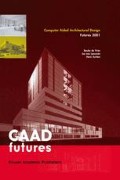Abstract
The current wave of attempts to create virtual design studios has demonstrated a wide range of didactical as well as computational models. Through work performed over the past year, an evolution of many of these concepts has been created which fosters a sense of place. This aspect of place has to do with identity and community rather than with form and space. Initial virtual design studio projects were often merely a digital pin-up board, which enabled distributed and asynchronous criticism and review. However, the web sites were more analogous to a directory than to the studio setting of an upper level design problem. The establishment of a truly distributed design studio in the past year, which involved design teams spread over three universities (not parallel to one another) led to the need for an independent place to share and discuss the student’s work. Previous virtual design studios have also established web sites with communication facilities, but one was always alone with the information. In order to enhance this virtual design studio and to give it a sense of place, a studio platform that serves as a console for participants was developed. The console is a front end to a dynamic database which mediates information about the participants, their work, timetables and changes to the dynamic community. Through a logon mechanism, the presence of members is traceable and displayed. When a member logs onto the console, other members currently online are displayed to the participant. An online embedded talk function allows informal impromptu discussions to occur at a mouseclick, thus imitating ways similar to the traditional design studio setting. Personal profiles and consultation scheduling constitute the core services available. Use of the platform has proven to be well above expected levels. The students often used the platform as a meeting place to see what was going on and to co-ordinate further discussions using other forums (videoconferences, irc chats or simple telephone conversations. Surveystaken at the end of the semester show a strong affinity for the platform concept in conjunction with a general frustration in pursuing collaboration with low bandwidth communication channels.
Access this chapter
Tax calculation will be finalised at checkout
Purchases are for personal use only
Preview
Unable to display preview. Download preview PDF.
References
Forgber, U., P. Russell, 1999, “The Virtual Design Studio”, Proceedings of the EAAE Annual Conference, Plymouth, UK, University of Plymouth, Plymouth
Russell, P., N. Kohler, U. Forgber, V. Koch, J. Rügemer, 1999, “The Virtual Design Studio as an Architectural Graphics Laboratory”, Turing to 2000: The 17th Annual eCAADe Conference, Liverpool, UK, University of Liverpool, Liverpool
Koch V., P. Russell, 2000, “VuuA.org: The Virtual Upperrhine University of Architecture”, Promise and Reality: 18th Annual eCAADe Conference, Weimar, Germany, University of Weimar, Weimar
Russell, P., U. Forgber, 2000, “INDeS: Interuniversity Networked Design Studios”, Promise and Reality: 18th Annual eCAADe Conference, Weimar, Germany, University of Weimar, Weimar
Elger, D, P. Russell, 2000, “Using the World Wide Web as a Communication and Presentation Forum”, Promise and Reality: 18th Annual eCAADe Conference, Weimar, Germany, University of Weimar, Weimar
Johnson, B., 2000, “Sustaining Studio Culture: How well do Internet Tools Meet the Needs of Virtual Design Studios?”, Promise and Reality: 18th Annual eCAADe Conference, Weimar, Germany, University of Weimar, Weimar
Author information
Authors and Affiliations
Editor information
Editors and Affiliations
Rights and permissions
Copyright information
© 2001 Springer Science+Business Media Dordrecht
About this paper
Cite this paper
Russell, P. (2001). Creating Place in the Virtual Design Studio. In: de Vries, B., van Leeuwen, J., Achten, H. (eds) Computer Aided Architectural Design Futures 2001. Springer, Dordrecht. https://doi.org/10.1007/978-94-010-0868-6_18
Download citation
DOI: https://doi.org/10.1007/978-94-010-0868-6_18
Publisher Name: Springer, Dordrecht
Print ISBN: 978-94-010-3843-0
Online ISBN: 978-94-010-0868-6
eBook Packages: Springer Book Archive

